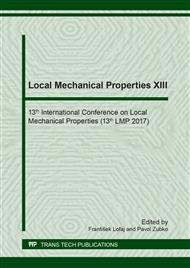[1]
S. Erden, K. Sever, Y. Seki, M. Sarikanat, Enhancement of the mechanical properties of glass/polyester composites via matrix modification glass/polyester composite siloxane matrix modification, Fibers. Polym. 11 (2010) 732-737.
DOI: 10.1007/s12221-010-0732-2
Google Scholar
[2]
S. Prashanth, K.M. Subbaya, K. Nithin, S. Sachhidananda, Fiber Reinforced Composites - A Review, J Material Sci. Eng. 6 (2017) 341.
Google Scholar
[3]
S. Bagherpour, Fibre Reinforced Polyester Composites, in: Hosam El-Din M. Saleh (Ed.), Polyester, InTech (2012),135-166.
DOI: 10.5772/48697
Google Scholar
[4]
C. M. Yang et al, Effect of ZnO/TiO2Nanorods Fabricated Using the Electrospinning Method in Y-Ba-Cu-O Single Grain Bulk Superconductors, IEEE Trans. Appl. Supercond. 27 (2017) 1-4.
DOI: 10.1109/tasc.2016.2625760
Google Scholar
[5]
E. Mudra, M. Streckova, D. Pavlinak, V. Medvecka, D. Kovacik, A. Kovalcikova, P. Zubko, V. Girman, Z. Dankova, V. Koval, J. Duzsa, Development of Al2O3electrospun fibers prepared by conventional sintering method or plasma assisted surface calcination, Appl. Surf. Sc. 415 (2017).
DOI: 10.1016/j.apsusc.2016.11.162
Google Scholar
[6]
A.M. Azad, Fabrication of transparent alumina (Al2O3) Nanofibers by electrospinning, Mater. Sci. Eng. A 435-436 (2006) 468-473.
DOI: 10.1016/j.msea.2006.07.075
Google Scholar
[7]
H. Wu, W. Pan, D. Lin, H. Li, Electrospinnig of ceramic Nanofibers: Fabrication, assembly and applications, J. Adv. Ceram. 1 (2012) 2-23.
Google Scholar
[8]
D. Li, Y. Xia, Fabrication of Titania Nanofibers by Electrospinning, Nano Lett. 3 (2003)555-560.
DOI: 10.1021/nl034039o
Google Scholar
[9]
O. Jirsak, F. Sanetrnik, D. Lukas, V. Kotek, L. Martinova, J. Chaloupek, A method of nanofibers production from a polymer solution using electrostatic spinning and a device for carrying out the method, WO 2005/024101 A1., (2005).
Google Scholar
[10]
O. Jirsak, P. Sysel, F. Sanetrnik, J. Hruza, J. Chaloupek, Polyamic acid nanofibers produced by needleless electrospinning, J. Nanomater. 2010 (2010) 1-6.
DOI: 10.1155/2010/842831
Google Scholar
[11]
K. Nakata, T. Ochiai, T. Murakami, A. Fujishima, Photoenergy conversion with TiO2 photocatalysis: New materials and recent applications, Electrochimica Acta 84 (2012) 103–111.
DOI: 10.1016/j.electacta.2012.03.035
Google Scholar
[12]
S. Mishra, S.P. Ahrenkiel, Synthesis and Characterization of Electrospun Nanocomposite TiO2 Nanofibers with Ag Nanoparticles for Photocatalysis Applications, Journal of Nanomaterials (2012) 902491.
DOI: 10.1155/2012/902491
Google Scholar
[13]
M. Grätzel, Dye-sensitized solar cells, J. Photochem. Photobiol. C4 (2003) 145–153.
Google Scholar
[14]
Y. Zhang, Y. Tang, W. Li, X. Chen, Nanostructured TiO2-Based Anode Materials for High-Performance Rechargeable Lithium-Ion Batteries, ChemNanoMat2 (2016) 764-775.
DOI: 10.1002/cnma.201600093
Google Scholar
[15]
X. Peng, Z. Wang, P. Huang, X. Chen, X. Fu, W. Dai, Comparative Study of Two Different TiO2 Film Sensors on Response to H2 under UV Light and Room Temperature, Sensors 16 (2016) 1249.
DOI: 10.3390/s16081249
Google Scholar
[16]
D.A.H. Hanaor, Ch.C. Sorrell, Review of the anatase to rutile phase transformation, J Mater Sci 46 (2011) 855–874.
DOI: 10.1007/s10853-010-5113-0
Google Scholar


